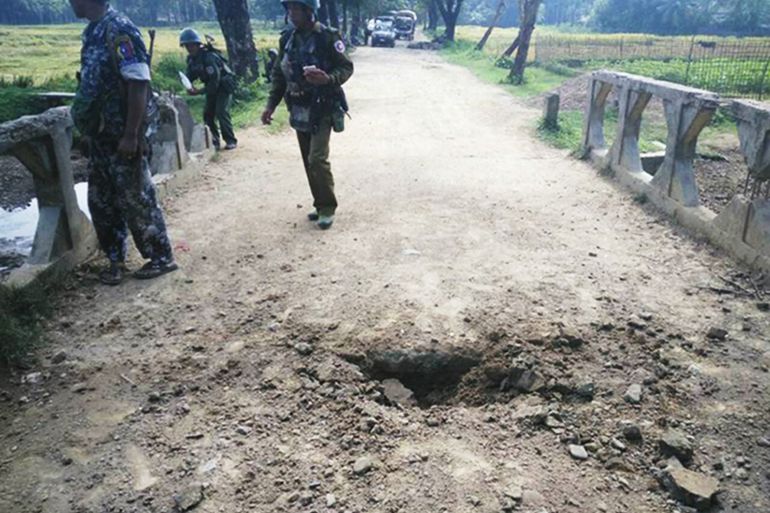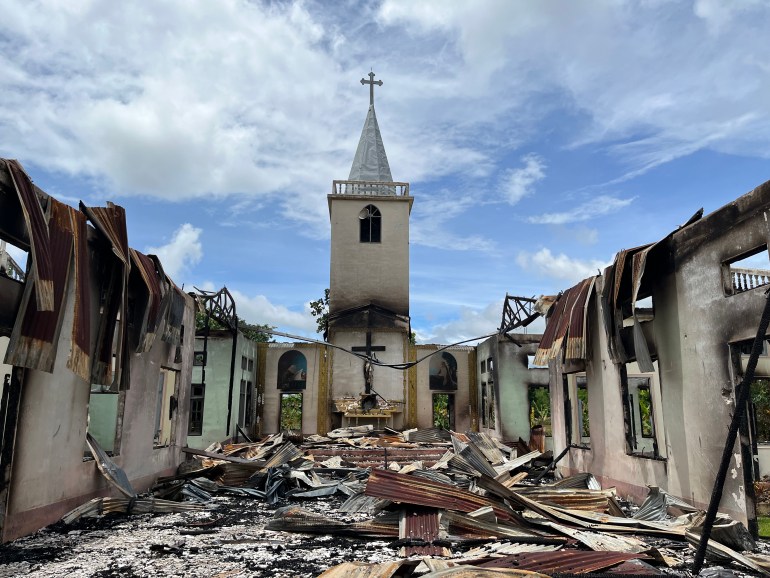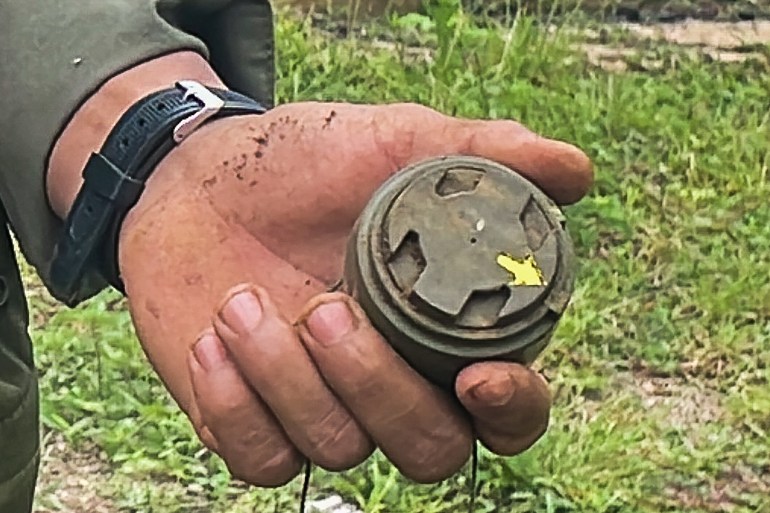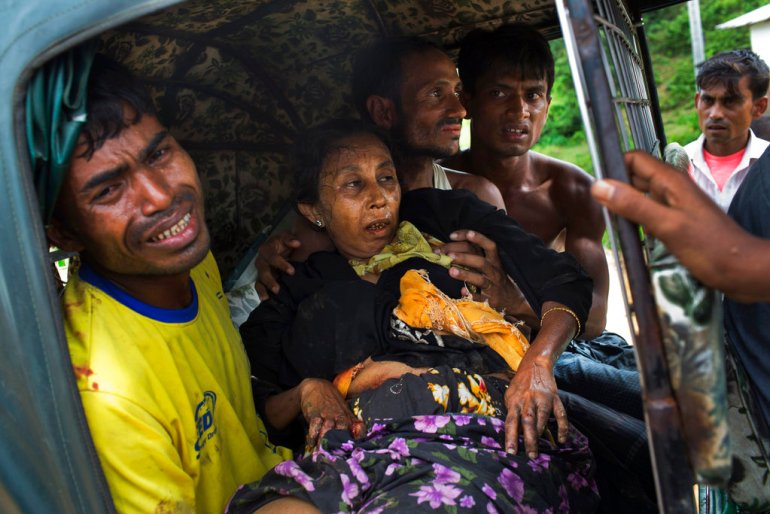‘The junta is heartless’: Landmine victims blame Myanmar military
Myanmar’s military accused of deliberately planting landmines to target civilians as armed resistance movement grows.

Chiang Mai, Thailand – Three months after she was forced to flee her village in Kayah State to avoid an attack by the Myanmar military, Say Myar decided to return to retrieve a supply of rice she had left behind.
Her husband had fallen ill, and the family was running low on food at the camp for internally displaced people where they were sheltering.
Keep reading
list of 4 itemsUnited Nations blocks Myanmar military taking UN seat
UN postpones decision on ambassadors from Myanmar, Taliban, Libya
UN Security Council resolution demands end to Myanmar violence
“A week before, two men went back to get some food and nothing happened,” she told Al Jazeera.
As she approached her abandoned home, Say Myar recalled how she first heard a loud blast. Then she realised the extent of her injuries — her right leg was blown off at the knee.
Her travel companions wrapped the wound and rushed her to a makeshift health centre, which managed to save Say Myar’s life.
“I was a farmer my whole life, but now it’s difficult to work. I feel sorry that I’ve become a burden for my husband,” she said.
Say Myar, in her 30s, is just one of the dozens of civilians killed and wounded by landmines planted by the Myanmar military.
In Kayah State alone, some 450km (280 miles) northeast of the country’s commercial capital Yangon, there were at least 20 civilian victims of landmines between June 2021 and July 2022, according to the Karenni Human Rights Group.
In one incident, the military was accused of planting landmines around a church before setting it on fire. A 16-year-old boy lost his foot while approaching the church to document the destruction.

“The military’s depraved use of landmines in homes and villages will continue to have devastating effects on civilians in Kayah State for years to come,” Rawya Rageh, senior crisis adviser at Amnesty International, said in a report from July.
“We know from bitter experience that civilian deaths and injuries will mount over time, and the widespread contamination is already blocking people from returning to their homes and farmland.”
Amnesty said Myanmar’s military commonly manufactures and uses M-14 landmines, which can blow a victim’s foot off at the ankle, and the more powerful MM-2s, which can take off a person’s leg at the knee.

‘The junta is heartless’
The military’s increased use of landmines in the past year comes amid widespread resistance in the country to the 2021 military takeover, which deposed the elected civilian government led by Aung San Suu Kyi and has plunged the country into an increasingly violent political crisis.
Kayah State has emerged as a stronghold of the pro-democracy armed resistance and has subsequently been subjected to widespread reprisals against civilians by the military.
“The junta is heartless. They plant landmines wherever they go, and they don’t remove them when they leave. They don’t care that villagers will step on them,” said Say Myar, adding she believes the military intentionally targets civilians.
Anthony Davis, a security analyst at leading defence and open-source intelligence group Janes, said the Myanmar military typically uses “factory-produced antipersonnel mines”, which it has been deploying in ever greater numbers to protect strategic sites such as military bases and police stations.
Antipersonnel mines, activated when a victim applies pressure, are prohibited under the international Mine Ban Treaty because of the inability of such weapons to differentiate between civilian and military targets. Myanmar is not a signatory to this treaty.

Local media abounds with reports of resistance groups — broadly known as People’s Defence Forces — also using “landmines” against the Myanmar military, although these are typically improvised explosive devices (IEDs) rather than factory-produced mines.
“PDF reliance on generally crude IEDs — mostly planted above ground — dates back to mid-late 2021 and reflects both a lack of small arms and a focus on interdicting military movements by road,” Davis said.
The IEDs used by resistance groups are often remote-detonated rather than victim-activated.
Yeshua Moser-Puangsuwan, a researcher for the International Campaign to Ban Landmines, said remote-command-detonated bombs are not subject to blanket prohibition under International Humanitarian Law in the same way as victim-activated mines. But such laws require that armed groups “distinguish between civilians and combatants” in their use of command-detonated explosives.
He said victim-activated landmines “cannot distinguish between a combatant or a civilian”, so their use violates basic principles of international humanitarian law.
“Likewise, if a combatant group uses a command-detonated bomb and destroys a civilian goods truck or a civilian ambulance or a civilian vehicle, they have violated this IHL prohibition,” he said.
However, Moser-Puangsuwan added that resistance groups have also occasionally used victim-activated landmines, both in the form of homemade IEDs and factory-produced antipersonnel mines captured from the Myanmar military.
“People’s Defence Forces [PDF] have manufactured a wide variety of improvised weapons, including remote-controlled roadside bombs, indirect fire weapons (rockets, mortars), improvised bomb-carrying drones, and improvised antipersonnel landmines. As reported, these have been used to cause military casualties. However they have also sometimes caused civilian casualties,” he said.
Davis, the security specialist, said the sad reality is that civilian casualties are almost expected within Myanmar, where support for the anti-military resistance remains strong.
“There’s a war on. Civilian casualties are regarded by both sides as ‘collateral damage’,” he said.
A battalion commander for the Karenni Nationalities Defence Force (KNDF), an anti-coup resistance group operating in Kayah State, confirmed that his armed group mostly uses “homemade” landmines.
“We always warn villagers not to travel to certain paths or areas if we use landmines. So far we have not had any case that villagers get injured by a PDF landmine,” he said.
Asked whether KNDF fighters ever used victim-activated landmines, the commander said that his forces mostly use tripwire explosives against the Myanmar military and always remove them – if they are not detonated – so that they do not harm civilians.
Moser-Puangsuwan said there is a “widespread belief in Myanmar” that “an indiscriminate weapon can be used discriminately”, which he called “fantasy warfare”.
He said what makes landmines so harmful is that they can leave entire communities “terrorised” and continue to take lives long after a conflict has ended.
“Landmines leave a deadly legacy for decades and have the unique ability to continue to claim war victims long after the peace was established,” he said.